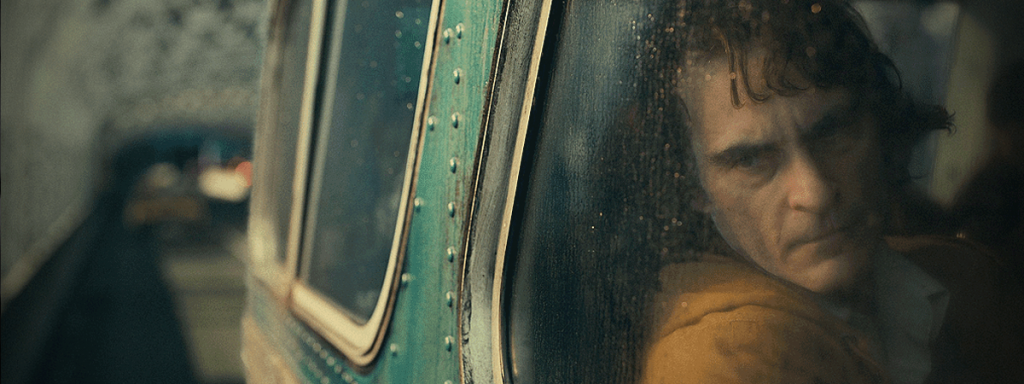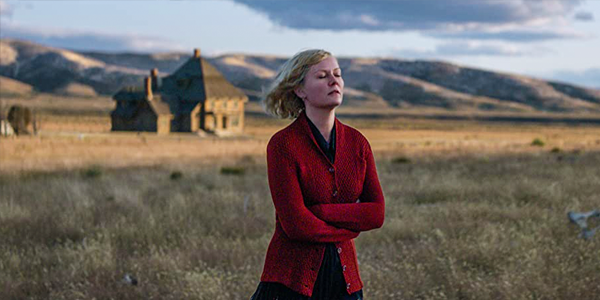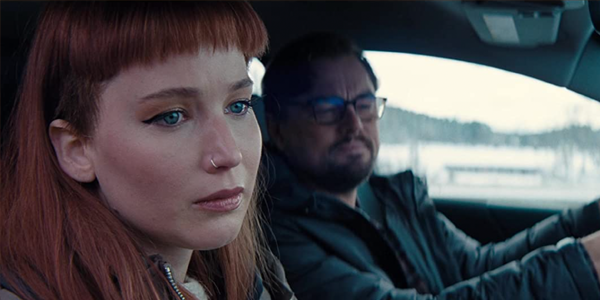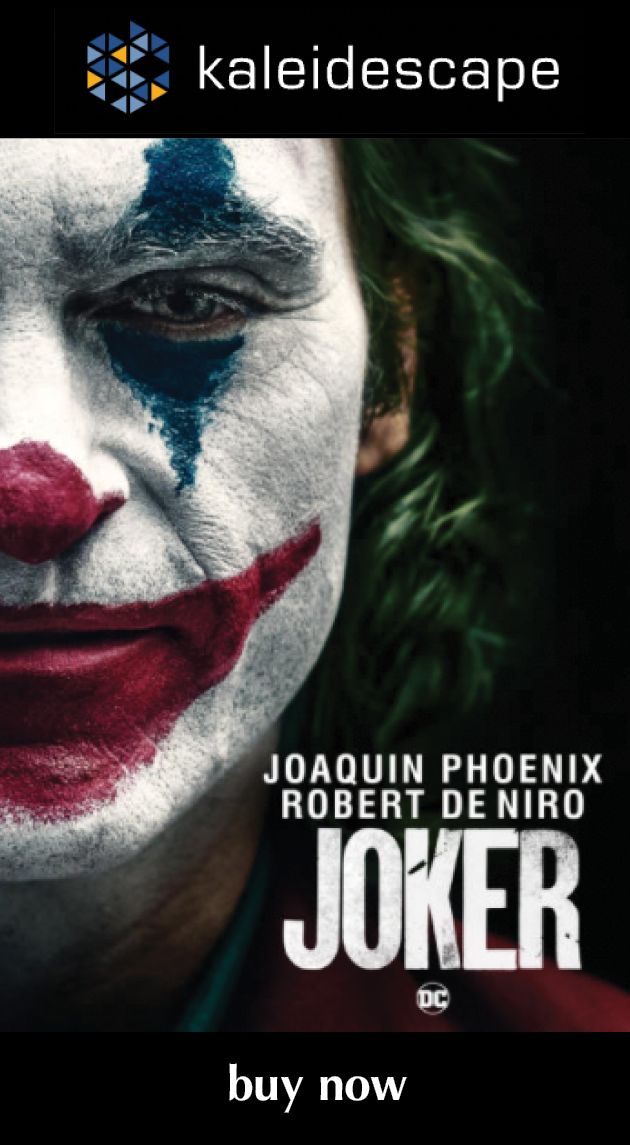
review | Joker
More character study than comic-book epic and definitely not an exercise in escapism, this genre evocation of ’70s NYC is very much anchored in Joaquin Phoenix’s performance
by Dennis Burger
December 18, 2019
I had to watch Todd Phillips’ Joker twice to write this review. And it required two viewings because I realized, as the credits rolled the first time, I had absolutely nothing meaningful to say about the video transfer or the sound mix. From beginning to end, I was so hypnotized (and horrified) by Joaquin Phoenix’ performance as the titular character that I honestly forgot I was supposed to be reviewing a home video release.
Had I gone ahead and put fingers to keyboard after that first viewing based on my hazy impressions, I would have told you a story about a grungy, filmic 4K HDR transfer that evoked the gritty neo-noir classics of the 1970s and ’80s. It took a second pass to realize that Joker’s cinematography is actually pristine, which makes sense given that it was captured digitally in a mix of 3.4K, 4.5K, and 5.1K resolutions, and finished in a 4K digital intermediate. It’s the set dressing, the lighting, the framing, and indeed the movement of the camera that evokes the look of the cinematic era the film aspires to. When you get right down to it, though, Joker is an objectively gorgeous film with a wonderfully revealing home video presentation.
The sound mix, too, would have gotten an inaccurate assessment had I not gone back for a double-dip. Hildur Guðnadóttir’s brilliant, minimalist cello score would have certainly been the focus of my discussion, as it dominates the mix, or at least one’s memory of it. But other than that, nothing really stuck to my ribs in terms of the overall delivery of audio, aside from a few distant ringing phones, ignored in the background, which struck me as being rendered with a wonderful illusion of space.
It wasn’t until the second time through that I even realized the soundtrack for the Kaleidescape release of the film is Atmos, but you shouldn’t take that oversight as an indication that the mix is subtle. Focusing more on the technical presentation than the performance at the heart of the film, it’s an ambitious and at times aggressive mix, one that uses its height channels to enhance the vertical elements of the filth-ridden cityscape of Gotham. (Not the stylized Gotham of the Burton or Nolan films, but a blatant homage to the New York City of ’70s cinema.) The fact that I barely noticed the height channels the first time is as much a credit to the artistry of the mix as it is to Phoenix’ mesmerizing performance. As with the imagery, the sound simply works in service of the narrative and never serves to distract from it.
If it seems as if the only aspect of the film itself I can focus on is the acting of its lead, there’s a reason for that. Joker isn’t story-driven. It’s as pure a character study as I’ve seen in ages. For those of us who love comic books and the movies based on them, it’s easy to go into a film like this—ostensibly an origin story about a character who has never had a consistent canonical backstory—with a ton of baggage. The thing is, though, Joker isn’t interested in your baggage. It isn’t interested in the 79-year history of the character as Batman’s archnemesis. Hell, it isn’t interested in Batman at all. Indeed, the overall mythology of Gotham City and its most famous residents is so tangential that it could have been left out of the film altogether and it wouldn’t have had any major effect on the plot, what little of it there is.
Director/co-writer Phillips seems so completely uninterested in any of the normal trappings of comic-book films that to call this a comic-book film at all feels dishonest. To discuss it in relation to the four-color serialized stories on which it is (very) loosely based would be to miss the point entirely. To understand the film, we have to view it for what it is: An exploration of the internal and external forces—personal and societal—that combine to create not merely a villain or a criminal but an unabashed agent of chaos, one that is, in this film, more man than myth.
In exploring all of this, Phillips touches upon a lot of conflict familiar to modern audiences—wealth inequality and the rage of the working class aimed at the apathetic ruling class, the failures of bureaucracy, media bias, our weird attitudes toward mental illness, our complex and often contradictory attitudes toward nonconformity.
As I mentioned, there isn’t a lot by way of plot here and it’s often difficult to figure out what Phillips wants us to take away from the film on any of these topics. Indeed, in the supplemental material included with the Kaleidescape download (and due to be included on the UHD Blu-ray release in January), he claims that the film isn’t really about any of these things. I’m not sure I buy that. I think it was easier to hide behind that dismissal than it was to admit that he doesn’t really have the answers—he simply wants us as an audience to do some of the heavy lifting and accept the unique part we play in creating such monsters, individually and collectively.
But it’s entirely possible you’ll come away from the film with completely different impressions than I did about whatever underlying message there may be. I, for example, couldn’t help but read into the narrative some serious thematic exploration about agency and free will, both topics I think about quite a bit. But in a few brief discussions with others who’ve seen the film, I seem to be alone in that, at least within my friend circle.
A lot of that has to do with how abstract Joker is at times. I referred to it as pure character study, and I stick by that. There are plenty of wonderful actors sharing the screen with Phoenix, namely Zazie Beetz, as well as Robert De Niro, whose character is largely a nod to The King of Comedy, a film that very much inspired elements of this one. But Arthur Fleck, aka “Joker,” is the film’s only real character.
As well as pure character study, Joker is also pure cinema—a work of art that simply couldn’t have existed in any other form than as a motion picture. Imagery and audio sit in the passenger seat alongside character development and story just sort of seems to be dragged along for the chaotic ride, hanging onto the rear bumper for dear life (and I assure you, I don’t mean that as a slight in any way).
That focus on fundamental human truths combined with the undeniable ’70s and ’80s aesthetic keep Joker from feeling too zeitgeisty, despite the current subject matter it grapples with. There is one thing, though, that betrays the film as absolutely not a product of the era it emulates. Many parallels have been drawn between Joker and Taxi Driver, and they’re not unfair. One crucial difference, though, is that this film’s titular character could not, in any light, be viewed as a hero or anti-hero or anything other than a force of nature unleashed by circumstance and his own weaknesses. To write it off as a mere mashup of Taxi Driver and The King of Comedy, would be intellectual laziness of the highest (and snottiest) order.
Phillips walks a very thin line: He wants you to understand this character without sympathizing with him. He doesn’t want you to want to watch the world burn—he simply wants you to recognize and acknowledge why some people do. And as with the best interpretations of this character (or at least the character that goes by this name) in print and on screen, Phillips wants you to admit that, as wrong as he may be and as dangerous as he may be, there’s an alluring element of truth behind the Joker’s lies, and refusing to admit as much is why we struggle to honestly understand the seemingly senseless acts of violence that have become so commonplace they barely register in the 24-hour news cycle unless the body count is truly catastrophic. To tiptoe right up to that line without crossing over into the territory of glorification is perhaps this film’s neatest trick.
In the end, though, I can imagine some viewers taking uncomfortable issue with this approach, with the lack of moralizing, the lack of overt condemnation for this murderous clown. Speaking for myself alone, I don’t think the film needs it. I think it’s implicit. I can’t imagine anyone cheering at the end of this cinematic tone poem. Then again, I didn’t see Joker in commercial cinemas, and I’m glad I didn’t. Because anything other than slack-jawed silence as its credits rolled would have confirmed my worst suspicions about humanity.
Viewed at home, via my own AV system, with no rustling snack packaging, whispering, cellphones glaring from the peripheral, or obtrusive snickering at the two or three overt references to comics history the film makes when it serves its purposes—in other words, taken on its own terms, and viewed without distraction—I can honestly say that this is one of the best films of 2019.
I can also say, without hesitation, that it’s one I’ll return to again and again, to meditate on its themes, its red herrings, and most importantly one of the most captivating, heartbreaking, frustrating, and fascinating character portrayals I’ve witnessed in ages. But it almost seems vulgar to discuss how beautifully shot it is, and how wonderful this home video presentation preserves its sumptuous cinematography.
Dennis Burger is an avid Star Wars scholar, Tolkien fanatic, and Corvette enthusiast who somehow also manages to find time for technological passions including high-end audio, home automation, and video gaming. He lives in the armpit of Alabama with his wife Bethany and their four-legged child Bruno, a 75-pound American Staffordshire Terrier who thinks he’s a Pomeranian.
PICTURE | Joker’s cinematography is pristine, resulting in an objectively gorgeous film with a wonderfully revealing home video presentation
SOUND | This is an ambitious and at times aggressive Atmos mix that uses its height channels to enhance the vertical elements of the filth-ridden cityscape of Gotham
© 2025 Cineluxe LLC






